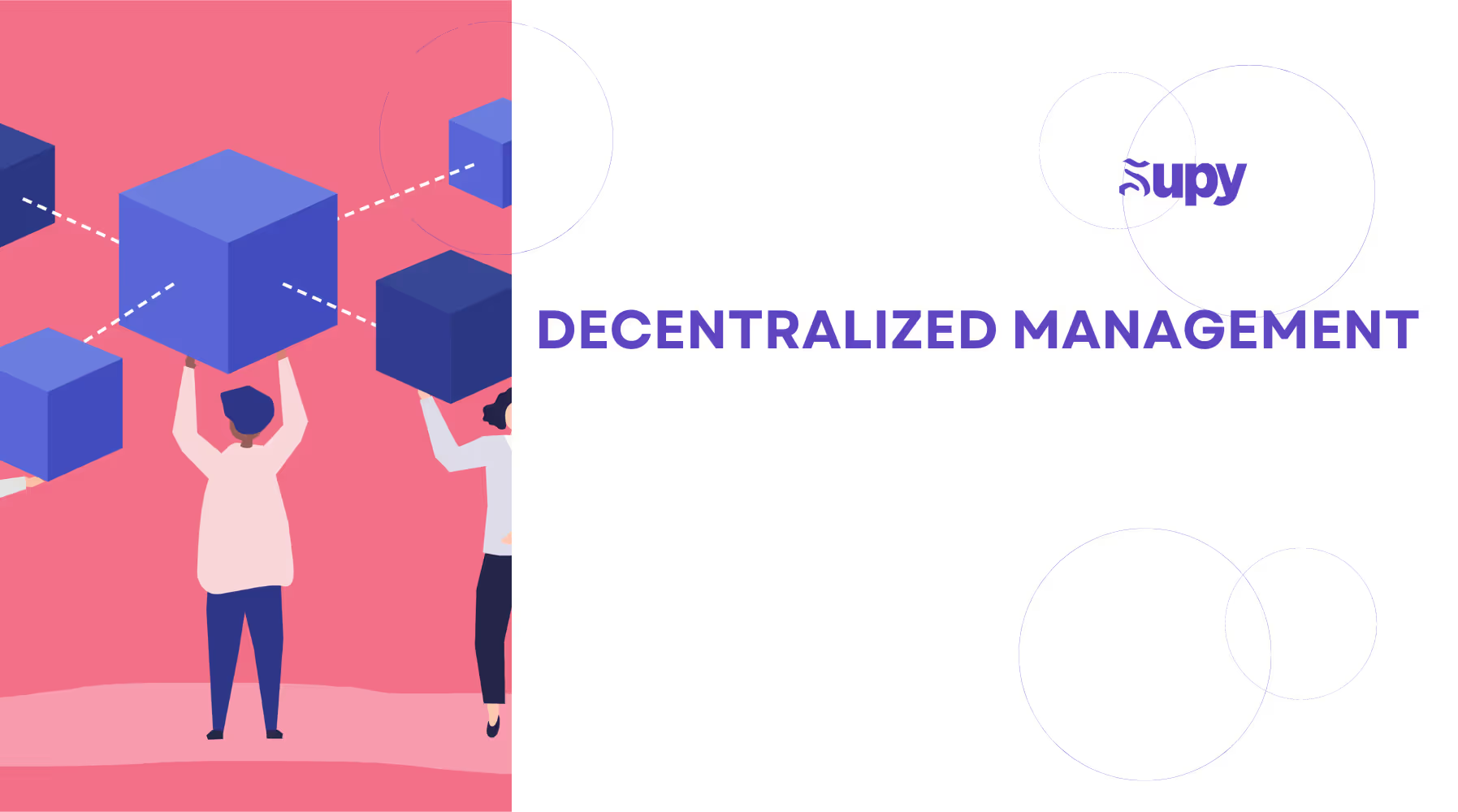Decentralized Management Restaurants: Benefits, Challenges, and Best Practices

Running a multi-location restaurant chain presents unique challenges. Slow decision-making, inefficiencies, and inconsistent operations can severely impact your ability to respond to market changes and customer needs.
In such cases, a decentralized management structure can offer a powerful solution. According to a study, management is a key driver of change in restaurants, accounting for 15.8% of the factors influencing change. This approach empowers local managers to make quick decisions, improving overall efficiency and employee morale.
In this blog, we'll explore:
- What is Decentralized Management?
- Benefits of a Decentralized Organizational Structure
- What are the Challenges of Decentralized Management?
- Centralized vs. Decentralized Management: Which is Best?
- Best Practices for Managing Multi-Branch Restaurants
- Conclusion
- About Supy
Decentralized management can help your restaurant chain, making it more adaptable and innovative.
1. What is Decentralized Management?

Decentralized management is a business model that distributes decision-making authority throughout the organization, rather than concentrating it at the top. This method empowers managers and team leaders at various levels to make independent decisions relevant to their areas of responsibility. It balances the desire for control with the need for agility, allowing businesses to adapt quickly in highly competitive industries.
This approach operates by delegating specific powers to lower-level managers who have a closer understanding of day-to-day operations and local market conditions. For instance, in a restaurant chain, a branch manager can adjust staffing or menu items based on immediate customer feedback or supply issues. By making their own decisions, these managers can respond more effectively to local demands.
A prime example of a decentralized organization in the restaurant industry is Chick-fil-A. The company utilizes an AI-powered decentralized approach, enabling individual locations to make decisions that best suit their specific market conditions. This strategy not only fosters innovation but also enhances the organization’s ability to respond dynamically to changes, ensuring sustained competitiveness and success.
2. Benefits of a Decentralized Organizational Structure

A decentralized model offers numerous advantages for businesses, especially those operating multiple locations. This approach distributes decision-making processes across various levels, fostering a more dynamic and responsive environment.
- Increased Responsiveness and Flexibility: Decentralized management allows businesses to respond quickly to changes in the market. Managers at each location can make immediate decisions based on local conditions, ensuring that the business remains agile and can adapt to new opportunities or challenges.
This flexibility is crucial in a fast-paced industry where customer preferences and market trends can shift rapidly. - Empowerment and Motivation of Employees: When decision-making power is distributed, employees at all levels feel more valued and empowered. This sense of ownership and responsibility can lead to higher levels of motivation and job satisfaction.
According to a study by Gallup, low engagement teams typically endure turnover rates that are 18% to 43% higher than highly engaged teams. Empowered employees are less likely to be actively looking or open to new job opportunities, and are more likely to go the extra mile to ensure the success of their local operations. - Better Understanding of Local Markets: Local managers in decentralized organizations have a deeper understanding of their specific markets, including customer preferences and regional trends.
This knowledge allows them to tailor their strategies and offerings to better meet the needs of their customers. By leveraging local insights, businesses can create more personalized and effective marketing campaigns, product offerings, and customer service initiatives. - Enhanced Innovation and Adaptability: Decentralized structures foster a culture of innovation by encouraging managers and employees to experiment and implement new ideas. This approach can lead to creative solutions and improvements that might not emerge in a more centralized system.
For instance, a local manager in a decentralized company might identify a new trend or customer need and quickly implement a pilot program to test its viability. - Improved Risk Management and Accountability: Decentralized management enhances risk management by spreading decision-making across multiple levels. This distribution reduces the impact of poor decisions and allows for quicker corrective actions.
Additionally, with more people involved in the decision-making process, there is greater accountability and oversight, reducing the likelihood of significant errors or oversights.
3. What are the Challenges of Decentralized Management?

While decentralized management offers many benefits, it also comes with significant challenges. These challenges can impact multi-location restaurants and bars, where maintaining consistency and efficiency is crucial. Understanding these hurdles is essential for implementing an effective decentralized structure.
1. Coordination and Consistency
One major challenge is maintaining consistency across different locations. Each manager in a decentralized organization may implement their own strategies and practices, leading to a lack of uniformity in customer experience, branding, and operational procedures.
For example, if one restaurant location decides to modify a popular dish to suit local tastes without informing other branches, it can confuse customers and dilute the brand's identity. Ensuring that all locations adhere to the company’s standards requires robust communication and oversight mechanisms from upper management.
2. Communication Issues
Effective communication is vital in a decentralized organization. Without clear and constant communication, there's a risk of misalignment between different branches and the central office. This misalignment can cause delays, misunderstandings, and inefficiencies.
According to a study by the Harvard Business Review, 69% of managers say that communication barriers are their biggest challenge. For instance, if a promotional campaign is launched at one location without notifying others, it can lead to missed opportunities and inconsistent marketing efforts.
3. Increased Administrative Overhead
Decentralization often requires additional administrative resources to manage the dispersed decision-making process. This can lead to higher operational costs and complexity. Ensuring that each location has the necessary resources and support while avoiding duplication of efforts can be challenging.
For example, separate inventory systems for each location might require more personnel and lead to inefficiencies compared to a centralized system.
4. Risk of Poor Decision-Making
Empowering local managers with decision-making authority can sometimes lead to suboptimal decisions, especially if they lack the necessary experience or information. Poor decisions at one location can negatively affect the brand's reputation and financial performance.
For example, if a manager orders too much perishable inventory based on incorrect sales forecasts, it can lead to waste and financial loss. Adequate training and support from upper management are crucial to mitigate this risk and ensure that managers do not lose sight of the bigger picture.
5. Difficulties in Implementing Change
Implementing company-wide changes can be more challenging in a decentralized structure. Each location may resist or adapt changes differently, leading to uneven implementation. This can slow down the process and reduce the effectiveness of new initiatives or strategies.
For instance, rolling out a new point-of-sale system across all locations might face delays if each manager has different levels of readiness or resistance to change.
6. Potential for Conflict
Decentralized management can sometimes lead to conflicts between different managers or departments, especially if their goals and strategies are not aligned. These conflicts can hinder cooperation and create a fragmented organizational culture.
A study by Gallup found that 85% of employees experience conflict at work, which can be developed in a decentralized environment. For example, a marketing campaign favored by one location might clash with the objectives of another, leading to internal disputes and inefficiencies.
4. Centralized vs. Decentralized Management: Which is Best?

Choosing between centralized and decentralized management depends on your business needs and goals. Each approach has its distinct advantages and challenges, particularly for multi-location restaurant chains. Let’s break down the key differences and considerations.
Centralized Management
A centralized structure concentrates decision-making power at the top levels of the organization. This ensures consistency and control across all locations. Key benefits include:
- Uniformity: Maintaining consistent brand standards and operational procedures.
- Streamlined Operations: Easier to implement company-wide policies and practices.
- Control: Centralized oversight can prevent deviations from company goals.
However, centralized organizations can experience:
- Slower Decision-Making: Local managers must wait for approvals from the central office.
- Reduced Flexibility: Less ability to quickly respond to local market conditions and customer needs.
Decentralized Management
Decentralized management distributes decision-making authority to local managers and team leaders. This approach offers:
- Agility: Quick responses to local market conditions and customer feedback.
- Employee Empowerment: Boosts morale and drives innovation by giving managers more control.
- Adaptability: Enhances local responsiveness, crucial for staying competitive.
Challenges of decentralized management include:
- Consistency Issues: Difficulty in maintaining uniform brand standards and customer experience.
- Coordination Challenges: Potential misalignment between different locations and the central office.
- Administrative Overhead: Higher operational costs due to additional resources needed for management.
Finding the Right Balance
Ultimately, the best approach may vary depending on the specific needs of your restaurant chain. A hybrid model that combines elements of both centralized and decentralized management could provide a balanced solution. This approach leverages the strengths of each model while mitigating their weaknesses:
- Centralized Control: Maintain consistency in branding and key operational areas.
- Decentralized Flexibility: Allow local managers the autonomy to innovate and quickly adapt to local market demands.
For instance, Supy's inventory management software realizes the importance of balancing centralized control with decentralized flexibility. With Supy's strictly defined roles, you can maintain centralized control by regulating who has access to critical functions like inventory management and pricing adjustments. This ensures that while local managers have the autonomy to make necessary changes, these changes are within a controlled framework that aligns with overall business strategies.
Moreover, Supy's approval workflows feature provides an added layer of oversight without stifling innovation. For example, if a local manager wants to introduce a new menu item or adjust stock levels, these changes can be submitted for approval through the system. This allows for a quick response to local needs while ensuring that all decisions are reviewed and aligned with the company's standards and goals.

5. Best Practices for Managing Multi-Branch Restaurants
Effectively managing a multi-branch restaurant requires a strategic approach that ensures consistency, efficiency, and adaptability across all locations. Here are some core best practices to consider:
1. Standardize Operations
Establishing standardized procedures for all locations is crucial. This includes everything from food preparation and service standards to health and safety protocols. Standardization ensures that each branch operates with the same level of quality and efficiency.
Developing comprehensive training manuals and conducting regular training sessions can help maintain these standards, which is particularly beneficial for integrating new employees and ensuring less risk associated with operational variations.
2. Implement Robust Communication Systems
Clear and consistent communication is vital for managing multiple branches. Utilize technology to facilitate communication between the centralized model of the top management and individual locations.
Tools like internal messaging apps, regular video conferences, and centralized dashboards can keep everyone informed and aligned with the company’s goals and updates, crucial for managing daily operations and ensuring that all parts of the organization move in concert.
3. Leverage Technology for Inventory Management
Efficient inventory management is essential for maintaining operational consistency and reducing costs. Implementing an advanced inventory management system can help track stock levels, automate ordering processes, and provide real-time data across all locations.
This ensures that each branch has the necessary supplies without overstocking or understocking, leading to better cost control and waste reduction. This technological support allows managers to make independent decisions effectively.
4. Empower Local Managers
Empowering local managers with decision-making authority can enhance responsiveness and adaptability. Provide them with the autonomy to make major decisions that best suit their specific market conditions and customer preferences.
However, ensure that this autonomy is balanced with accountability through regular performance reviews and clear guidelines. Empowered managers are more likely to be proactive and motivated, driving better results for their branches, embodying the decentralized ethos that allows for more autonomy in managing daily operations.
5. Monitor Performance and Provide Feedback
Regularly monitoring the performance of each branch is crucial for maintaining high standards. Use key performance indicators (KPIs) such as sales figures, customer satisfaction scores, and employee turnover rates to assess each location’s performance.
Providing constructive feedback based on these metrics helps in identifying areas for improvement and recognizing successful practices that can be replicated across other branches. This feedback loop is vital for long-term strategic decisions, ensuring that all branches align with broader corporate goals while also adapting to local needs.
6. Conclusion
Decentralized management offers significant benefits for multi-location restaurant chains, such as increased responsiveness, employee empowerment, and better understanding of local markets. However, it also presents challenges, including coordination issues, communication problems, and the risk of inconsistent operations.
By finding the right balance between centralized control and decentralized flexibility, and implementing best practices like standardizing operations, robust communication, and empowering local managers, restaurant chains can achieve both efficiency and adaptability. This strategic approach ensures a high-quality customer experience and sustained competitiveness in a dynamic market.
7. About Supy
Supy streamlines inventory management for the hospitality industry, particularly for multi-location restaurants and bars. By integrating centralized control with the flexibility needed for local decision-making, Supy helps streamline operations and maintain consistent quality across all locations.
Its features, such as user permissions and approval workflows, empower local managers to act swiftly while ensuring alignment with overall business strategies. To learn more about how Supy can enhance your restaurant management, schedule a demo today and see the benefits firsthand.
Related Resources







